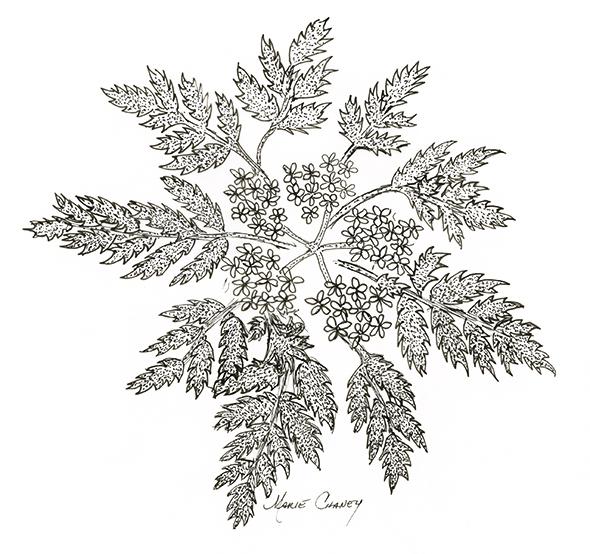All week on Wild Things we’ll be presenting our favorite dangerous, horrifying, and monstrous plants, excerpted from The Big, Bad Book of Botany: The World’s Most Fascinating Flora by Michael Largo. Out now from William Morrow.
Hemlock is yet another highly toxic plant that can cause serious health problems, even death. Conium maculatum is a genus of two poisonous species of herbaceous, perennial, flowering herbs in the Apiaceae family. The hemlock species is native to the Mediterranean region, and the other, called Conium chaerophylloides, comes from Southern Africa. Some theorize the name of “hemlock” comes from the Old English “humlice,” which was the name of the tree. The plant has other names, such as woomlick, beaver poison, poison parsley, bunk, hever, caise, devil’s flower, and gypsy flower. It even has more regional nicknames: break-your-mother’s-heart (wow!), lady’s lace, scabby hands, and others. A very inspiring plant, obviously. The conium name derives from the Greek konas, meaning “vertigo” or “whirl”—both symptoms of the plant’s intoxicating poison.
Hemlock is a biennial, herbaceous plant that can grow from 3 to 5 feet tall. It has a smooth green stem, often streaked or spotted on the lower half with purple or red—a warning from nature of the plant’s toxicity. Its leaves have an overall triangular shape, divided and lacy, growing about 1½ feet long and nearly as wide. Its small white flowers, clustered in umbels, are a ½ inch in diameter. When you crush a hemlock leaf or root, it emits an unpleasant, rank odor, similar to that of parsnips.
Hemlock is native to the tempered regions of West Asia, Europe, and North Africa, but has since spread to North America, Australia, and New Zealand. It often grows near surface waters, such as streams and ditches, as well as on waste areas, on roadsides, and on the edges of cultivated fields. In some countries, it is treated as an invasive plant. Conium maculatum prefers damp areas with poorly drained soils; it flourishes in early spring, before other foliage appears. Hemlock is not actually related to the hemlock tree, which is in the pine family, and not at all poisonous. The tree gets its name from its needles, which, when crushed, give off a similar smell to the toxic hemlock shrub.
Hemlock contains conhydrine, N-methylconine, but its most poisonous alkaloid is coniine, which has a chemical structure similar to nicotine. This poison disrupts the central nervous system—a small dose can cause respiratory collapse. Death can result from blockage of the neuromuscular junction caused by coniine. In practice, it eventually stops your ability to breathe, causing you to suffocate. This won’t happen right off, and drinking its tea only makes you feel drunk at first. It may take from 48 to 72 hours for the full toxic effects to manifest. If you find yourself so poisoned, only artificial or mechanical ventilation can save you.
According to Christian mythology, the hemlock plant became poisonous after growing on the hillside of Jesus’ crucifixion. When his blood touched the plant, it turned forever toxic. However, the most infamous poisoning by hemlock is attributed to the Greek philosopher Socrates, who chose a hemlock drink as his preferred means of death—most sources say that he drank it mixed with water or as a tea. In the Phaedo, Plato claims that Socrates first felt a numbing in his limbs, after which the sensation overtook his entire body. Socrates maintained full awareness throughout his poisoning and even continued to speak to those around who witnessed his death. His last words reportedly were: “Crito, we owe a cock to Asclepius. Please, don’t forget to pay the debt.” Socrates willingly drank the poison after being sentenced to death for his speeches and for his belief in humanistic and democratic principles. When he was ordered to publicly deny his ideas or die, he chose death. However, as a respected gentleman, the court gave him the right to pick the manner in which he wished to have his death sentence carried out. Hemlock tea was his first choice.
In Socrates’ last moment of lucidity he mentions the god Asclepius, a mythological deity noted for healing. Scholars surmise that Socrates conceived of his death as a freedom of his soul from the unreasonableness of humanity and the confines of his body. However, Plato’s dignified description of Socrates’ death might be a bit romanticized, since hemlock poisoning would be a lot more painful, accompanied by a convulsive gasping to breathe.
Excerpted from The Big, Bad Book of Botany: The World’s Most Fascinating Flora by Michael Largo. Out now from William Morrow, an imprint of HarperCollins Publishers. Reprinted by permission.
